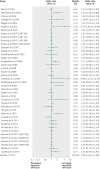Off-hour presentation and outcomes in patients with acute myocardial infarction: systematic review and meta-analysis
- PMID: 24452368
- PMCID: PMC3898160
- DOI: 10.1136/bmj.f7393
Off-hour presentation and outcomes in patients with acute myocardial infarction: systematic review and meta-analysis
Abstract
Objective: To assess the association between off-hour (weekends and nights) presentation, door to balloon times, and mortality in patients with acute myocardial infarction.
Data sources: Medline in-process and other non-indexed citations, Medline, Embase, Cochrane Database of Systematic Reviews, and Scopus through April 2013.
Study selection: Any study that evaluated the association between time of presentation to a healthcare facility and mortality or door to balloon times among patients with acute myocardial infarction was included.
Data extraction: Studies' characteristics and outcomes data were extracted. Quality of studies was assessed with the Newcastle-Ottawa scale. A random effect meta-analysis model was applied. Heterogeneity was assessed using the Q statistic and I(2).
Results: 48 studies with fair quality, enrolling 1,896,859 patients, were included in the meta-analysis. 36 studies reported mortality outcomes for 1,892,424 patients with acute myocardial infarction, and 30 studies reported door to balloon times for 70,534 patients with ST elevation myocardial infarction (STEMI). Off-hour presentation for patients with acute myocardial infarction was associated with higher short term mortality (odds ratio 1.06, 95% confidence interval 1.04 to 1.09). Patients with STEMI presenting during off-hours were less likely to receive percutaneous coronary intervention within 90 minutes (odds ratio 0.40, 0.35 to 0.45) and had longer door to balloon time by 14.8 (95% confidence interval 10.7 to 19.0) minutes. A diagnosis of STEMI and countries outside North America were associated with larger increase in mortality during off-hours. Differences in mortality between off-hours and regular hours have increased in recent years. Analyses were associated with statistical heterogeneity.
Conclusion: This systematic review suggests that patients with acute myocardial infarction presenting during off-hours have higher mortality, and patients with STEMI have longer door to balloon times. Clinical performance measures may need to account for differences arising from time of presentation to a healthcare facility.
Conflict of interest statement
Competing interests: All authors have completed the ICMJE uniform disclosure form at
Figures



Comment in
-
Acute myocardial infarction.BMJ. 2014 Jan 21;348:f7696. doi: 10.1136/bmj.f7696. BMJ. 2014. PMID: 24452407 No abstract available.
-
Associations and clinical significance in meta-analysis: when are the deductions too presumptive?J R Coll Physicians Edinb. 2014;44(2):131-2. doi: 10.4997/JRCPE.2014.209. J R Coll Physicians Edinb. 2014. PMID: 24999775 No abstract available.
Similar articles
-
Off-Hours Presentation, Door-to-Balloon Time, and Clinical Outcomes in Patients Referred for Primary Percutaneous Coronary Intervention.J Invasive Cardiol. 2023 Apr;35(4):E185-E193. doi: 10.25270/jic/22.00367. Epub 2023 Feb 24. J Invasive Cardiol. 2023. PMID: 36827083
-
Door-to-Balloon Time and Clinical Outcome of Patients Presenting with ST-Segment Elevation Myocardial Infarction During on and off Hours: a Single Center Study.Med Arch. 2025;79(3):172-180. doi: 10.5455/medarh.2025.79.172-180. Med Arch. 2025. PMID: 40657341 Free PMC article.
-
Off-hour presentation and outcomes in patients with acute ischemic stroke: a systematic review and meta-analysis.Eur J Intern Med. 2014 Apr;25(4):394-400. doi: 10.1016/j.ejim.2014.03.012. Epub 2014 Apr 12. Eur J Intern Med. 2014. PMID: 24721584
-
[Volume and health outcomes: evidence from systematic reviews and from evaluation of Italian hospital data].Epidemiol Prev. 2013 Mar-Jun;37(2-3 Suppl 2):1-100. Epidemiol Prev. 2013. PMID: 23851286 Italian.
-
A systematic review of factors predicting door to balloon time in ST-segment elevation myocardial infarction treated with percutaneous intervention.Int J Cardiol. 2012 May 17;157(1):8-23. doi: 10.1016/j.ijcard.2011.06.042. Epub 2011 Jul 14. Int J Cardiol. 2012. PMID: 21757243
Cited by
-
Outcomes of off- and on-hours admission in ST-segment elevation myocardial infarction patients undergoing primary percutaneous coronary intervention: A retrospective observational cohort study.Medicine (Baltimore). 2016 Jul;95(27):e4093. doi: 10.1097/MD.0000000000004093. Medicine (Baltimore). 2016. PMID: 27399103 Free PMC article.
-
Weekend versus weekday admission and short-term mortality: A meta-analysis of 88 cohort studies including 56,934,649 participants.Medicine (Baltimore). 2017 Apr;96(17):e6685. doi: 10.1097/MD.0000000000006685. Medicine (Baltimore). 2017. PMID: 28445269 Free PMC article. Review.
-
Primary Percutaneous Coronary Intervention during Off-Hours: One-Decade Experience from a High-Volume Cardiovascular Center.Arq Bras Cardiol. 2024 Nov 22;121(11):e20240396. doi: 10.36660/abc.20240396. eCollection 2024. Arq Bras Cardiol. 2024. PMID: 39607224 Free PMC article. English, Portuguese.
-
Protocols for Endovascular Stroke Treatment Diminish the Weekend Effect Through Improvements in Off-Hours Care.Front Neurol. 2018 Dec 18;9:1106. doi: 10.3389/fneur.2018.01106. eCollection 2018. Front Neurol. 2018. PMID: 30619062 Free PMC article.
-
Acute Coronary Syndrome Presenting during On- and Off-Hours: Is There a Difference in a Tertiary Cardiovascular Center?Medicina (Kaunas). 2023 Aug 4;59(8):1420. doi: 10.3390/medicina59081420. Medicina (Kaunas). 2023. PMID: 37629710 Free PMC article.
References
-
- Clarke MS, Wills RA, Bowman RV, Zimmerman PV, Fong KM, Coory MD, et al. Exploratory study of the ‘weekend effect’ for acute medical admissions to public hospitals in Queensland, Australia. Intern Med J 2010;40:777-83. - PubMed
-
- Kostis WJ, Demissie K, Marcella SW, Shao YH, Wilson AC, Moreyra AE. Weekend versus weekday admission and mortality from myocardial infarction. N Engl J Med 2007;356:1099-109. - PubMed
-
- Kruth P, Zeymer U, Gitt A, Junger C, Wienbergen H, Niedermeier F, et al. Influence of presentation at the weekend on treatment and outcome in ST-elevation myocardial infarction in hospitals with catheterization laboratories. Clin Res Cardiol 2008;97:742-7. - PubMed
Publication types
MeSH terms
LinkOut - more resources
Full Text Sources
Other Literature Sources
Medical
Miscellaneous
